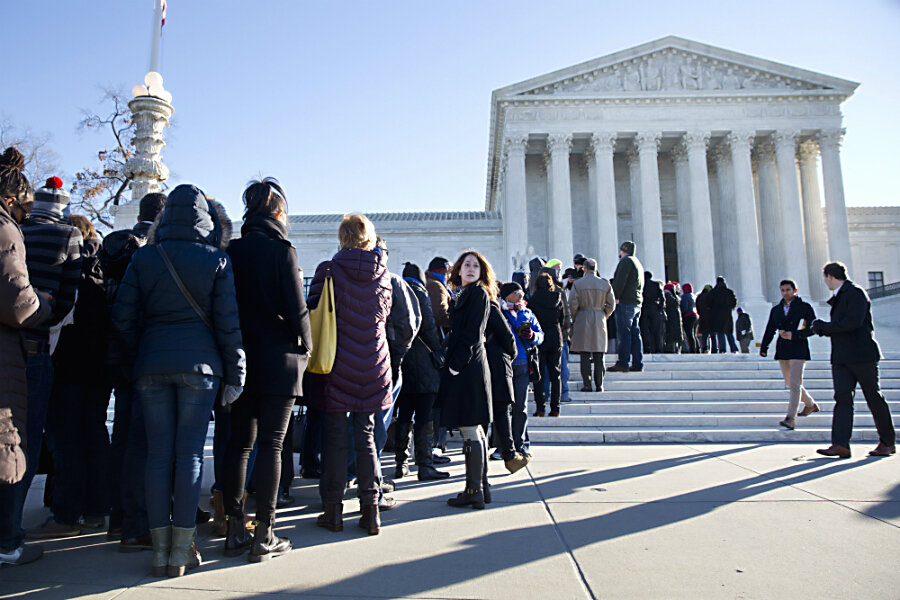In key test for public-sector unions, Supreme Court hits 'pause'
Loading...
The long-running battle between conservatives and labor unions flared briefly this week until the Supreme Court hit the pause button – a hiatus that should last through the end of the year.
The fighting likely will resume once a new president takes office. Even during this quiet period, the balance of power will hit a new tipping point. On July 1, West Virginia will become the 26th right-to-work state, the first time a majority of states have dramatically curtailed union power since sweeping labor-friendly laws were passed during the 1930s.
“There has just been a firestorm of state legislation that has restricted the ability of unions to operate, that has targeted their ability to be politically relevant, that has weakened and dialed back the benefits that have been negotiated,” says Robert Bruno, professor of labor and employment relations at the University of Illinois at Urbana-Champaign. “There have been hundreds of such bills.”
The battle is taking place along two fronts: in the courts and in state legislatures. The latest court action involves public-sector unions. On Tuesday, the labor movement avoided a key loss when the US Supreme Court deadlocked 4 to 4 over whether California teachers have to pay fees to the union that represents them when it negotiates contracts. Buena Park, Calif., elementary teacher Rebecca Friedrichs argues she’s being forced to support a union that protects ineffective teachers rather than educating children.
Already, unions can’t force nonmembers to pay for union political activity. But in 1977, in Abood v. Detroit Board of Education, the high court upheld mandatory fees for collective bargaining, saying the arrangement counteracted "free riders" who might refuse to contribute but would still enjoy the benefits of union representation at the bargaining table. “Right to work” involves measures that prevent unions from forcing workers to become members or to pay union dues or fees.
Right-to-work proponents had hoped the court would reverse the Abood decision, but with the passing of Justice Antonin Scalia, it split 4 to 4. That effectively affirmed a lower court ruling that cited Abood in ruling in favor of the union in Friedrichs v. California Teachers Association.
Lawyers for Ms. Friedrichs say they may request that the high court to rehear the case, presumably when a ninth justice is installed. Given the refusal of Congress’s majority Republicans to hold hearings on President Obama’s nominee for the court, it looks like a rehearing won’t happen until a justice is approved after the election.
“Unless something happens with Friedrichs – even then it would be unlikely [before a new justice is installed] – I don’t think there's anything” before the election, says Patrick Semmens, vice president of The National Right to Work Foundation in Springfield, Va. But the group does have a related case pending before the court involving a proposed class action for child-care providers who are trying to get reimbursed for the fees they paid a union.
The decades-long battle over right-to-work initiatives has pushed organized labor onto the defensive. The Friedrichs case represents a threat to public-sector unions, which represent one of the last bastions of labor strength. In California, for example, where the Friedrichs case originated, 58.6 percent of government employees are unionized, one of the highest rates in the nation. In California’s private sector, by contrast, only 9.6 percent of workers are unionized. Even in antiunion Georgia, 1 in 7 government workers belong to a union vs. 1 in 29 in the private sector, according to the website unionstats.com.
The battle has political ramifications. If conservatives can chip away at the funding of public-employee unions, they can weaken them and, in turn, hurt labor’s ally, the Democrats. “It's totally political,” says Ross Eisenbrey, vice president at the Economic Policy Institute, a foundation- and union-supported think tank in Washington. “The business community doesn't like unions by and large, and whenever they get an opportunity to undermine collective bargaining, they take it.”
The new wave of states adopting right-to-work initiatives also represents an existential threat to what’s left of the private-sector union movement. Some of the most recent gains have been made in industrial states – Michigan, Indiana, and Wisconsin – that at one time represented the heart of the labor movement.
Whether right to work measures improve job growth or boost employment is subject to intense debate between the two sides. Recent research suggests that the decline of unions has boosted income inequality since the 1970s, but how much is in dispute.
The election in November will define where the battle heads next. If a Republican wins the presidency, a conservative justice would create a high court majority that could overturn longstanding pro-labor rulings. If a Democrat wins, the action is likely to remain in state legislatures. Since 2012, four states will have tipped into the right-to-work column; in the previous 33 years, only three states did.








